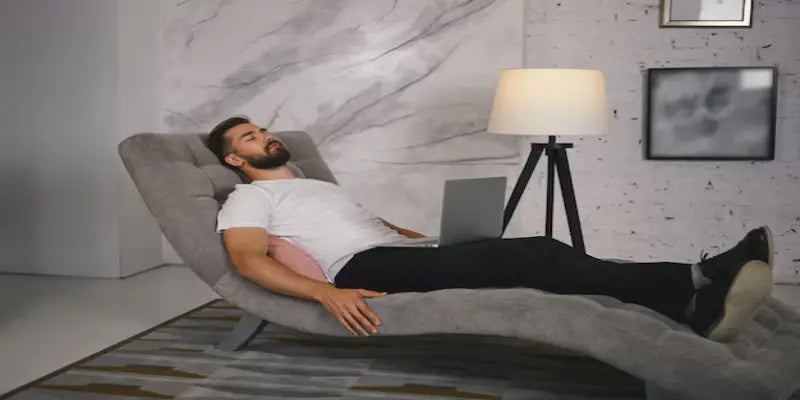
Sleeping in Fetal Position
Sleeping postures can reveal a lot about a person's personality and mindset. The fetal position is one of the most prevalent sleeping positions. Sleepers generally prefer the fetal position because it creates a sense of comfort and security. It can help people cope with stress and anxiety by unconsciously reminding them of a safer, more secure time in the womb. But it does have some downsides.
In this blog, we'll explain everything about fetal position, what it means, pros and cons of fetal sleeping position, steps to get into fetal sleeping position and other common sleeping positions you can try to sleep peacefully at night.
What is the Fetal Sleep Position?
Sleeping in the fetal position is when you lie on your side and raise your knees to your chest. When sleeping in this position, some people support their head by curling one arm beneath their pillow while some people don’t. Because it resembles the position of a fetus in the womb, it is known as the fetal position.
As you age, sleeping on your side becomes more desirable. While older adults sleep more on their sides, children often sleep on their stomachs, sides, and backs in equal amounts.
The Benefits of Sleeping in the Fetal Position
There are a lot of benefits to sleeping in the fetal position, and many people believe it’s one of the best ways to sleep.
Here are six reasons why sleeping in the fetal position is good for you:
- It Encourages Proper Sleep Positioning: Sleeping in the fetal position puts your body in a natural position to sleep, which encourages proper sleep positioning. This can help prevent neck and back pain, headaches, and other injuries caused by bad sleep habits.
- It Reduces Stress Levels: Studies have shown that people who sleep in the fetal position tend to have lower levels of stress hormones in their blood than those who don’t. This may be because spending time in the fetal position reduces exposure to light and noise, both of which can contribute to stress levels.
- It Improves Circulation: When you sleep on your side or on your stomach, you put pressure on your blood vessels near your heart. Sleeping in the fetal position allows blood flow to move more easily through these vessels, which can improve circulation and reduce inflammation.
- It Allows Your Body To Rest Easier: When you are lying flat on your back, your muscles are constantly working to keep you upright. Lying on your side or stomach allows your muscles to rest, which can help reduce pain and inflammation throughout your body.
- It May Help Reduce The Risk Of Sudden Infant Death Syndrome (SIDS): Babies who sleep on their sides or stomachs are less likely to die from SIDS than babies who sleep on their backs. This is probably because lying on your side or stomach reduces the amount of air that your baby can inhale and reduces the risk of suffocation.
- It Reduces The Risk Of Breastfeeding Problems: When you are breastfeeding, it’s important to keep your body as still as possible so your milk can flow freely. Sleeping in the fetal position can help you do this by reducing the amount of movement around your breasts.
Fetal Position Sleep: Good or Bad?
There are pros and cons to sleeping in the fetal position, but it's generally considered a good sleep habit.

Here are some pros and cons of sleeping in fetal position:
Pros of Sleeping in Fetal Position:
- It's Comfortable: Sleeping in the fetal position is usually comfortable because your body is in its natural shape. You can also relax your entire body, which can help you fall asleep faster.
- It Prevents Rashes and Allergies: Sleeping in the fetal position can help prevent rashes and allergies because it helps keep your skin clean.
- It Can Help You Breathe Easier: When you're sleeping on your back, your belly presses down on your lungs, which can cause breathing problems. But when you sleep in the fetal position, gravity helps push your lungs up toward your throat, which can improve breathing.
- It Reduces Stress Levels: When you're stressed out, it's difficult to fall asleep because you're busy thinking about everything that's going on. But when you sleep in the fetal position, you reduce stress levels by calming down your brain and body.
Cons of Sleeping in Fetal Position:
- Can Cause Pain: Sleeping in the fetal position can cause pain in your knees, hips, back, and neck. This is because the position puts constant stress on the ligaments and muscles in these areas. It can also make existing back and neck pain worse.
- Inflammation: The fetal position can cause inflammation in the ligaments around your knees and hips. It can also cause inflammation in your neck muscles, which can put pressure on your upper spine.
- Spinal Deformities: In many cases, it is seen that sleeping in the fetal position for a long time can lead to spinal deformities.
- Limited Breathing: Sometimes some people when sleeping in fetal position, can curl up too tightly which can make it hard to breathe deeply.
Steps to Get into a Fetal Position for Sleeping
There are many different ways to get into a fetal position for sleeping, but the best way to find out is by trying them out. The fetal position can help to reduce pressure on your back and neck, which can help you sleep better.
Here are some tips on how to get into the fetal sleeping position:
- Lie down on your back with your head and shoulders off the bed.
- Place your hands behind your head, then fold your legs up toward your chest.
- Tuck your tailbone under so that you have a small curve in your back.
- Keep your hips and knees bent so that you form a C-shape with the rest of your body. You may want to use pillows or rolled-up blankets to help support your lower body if needed. For pillows you can always count on Sleepsia. Sleepsia pillows are unique in the way that they are designed to improve your sleep. They are made with special materials that help you to relax and get a good night’s sleep. The pillow is filled with gel that helps to distribute your weight evenly, which in turn helps you get a good night’s sleep. Sleepsia pillows also come with a cover that helps to keep the pillow clean, and it has an adjustable height so that you can find the perfect fit for your sleeping needs.
The Science Behind Sleep Positions

There is a lot of confusion about the science behind best sleep positions. People are often told to change their position every night, but what does this really mean? Are all positions equally good for sleep? The answer to these questions is a little bit complicated, but it all comes down to what works best for your individual body and bedroom environment.
There are three main types of sleep: supine, prone, and side. Supine means you're lying on your back with your head and shoulders flat on the bed. Prone means you're lying on your stomach with your head and shoulders resting on the bed surface. Side means you're lying on one side with your head and/or arm hanging over the edge of the bed.
Each type of sleep has its own benefits and drawbacks. Supine sleeping is generally considered to be the most comfortable form of sleeping because it allows your spine to rest in a neutral position. It's also thought to be more likely to cause snoring and other breathing problems if done incorrectly because it forces airways open into the throat.
Prone sleeping can be more comfortable if you have neck pain or trouble sleeping on your back, but it can also increase risk for injury if you fall off the bed during sleep or suffer from an accident while asleep. Side sleeping may be less comfortable than supine or prone sleeping, but it's thought to be more effective at promoting deep sleep because it reduces pressure on both spinal cord discs (the protectors around spinal cord ) and the skull.
The best sleep position for you will vary depending on your individual needs and preferences. Some people find that they sleep better when they're on their side, while others find that they're more comfortable when they're lying on their back. It's important to experiment a little bit and see what works best for you before making any drastic changes to your sleep routine.
Also Read:- Spooning Position Sleep
Other Common Sleep Positions

There are many different types of sleep positions and each has its own benefits and drawbacks. To get the most restful sleep, it’s important to find a position that works best for you.
Here are four different types of sleep positions and their associated benefits:
- Back Sleeper: Back sleepers usually have a relaxed posture because their upper body is supported by pillows. This position is good for people who tend to toss and turn throughout the night. Back sleepers often experience less muscle tension and can wake up feeling rested.
- Side Sleeper: Side sleepers typically have a more upright posture because their head and shoulders are off the pillow. This position can be tiring if you shift around a lot in your sleep, but side sleepers often report better circulation due to less obstruction of blood flow to the head. Side sleepers also tend to snore less than back or stomach sleepers.
- Stomach Sleeper: Stomach Sleepers lay on their stomachs which puts pressure on the diaphragm, one of the major muscles in the chest that helps us breathe. This position can be difficult to get used to at first, but stomach sleeper’s often enjoy better breathing patterns due to reduced snoring and congestion during REM sleep (rapid eye movement).
- Tummy sleeper: Tummy Sleepers lie on their bellies with their hands tucked under them or crossed over their chests like fetal position. This is considered a “couch-potato” sleep position because it’s not as restful as other positions and tends to cause more snoring.
How to Choose the Perfect Pillow?
There are a few things you need to consider before buying a pillow. The first is your sleep style. Do you like sleeping on your side or stomach? If you're someone who likes to sleep on their back, then a cervical contour pillow might be a better fit for you. You also need to decide which type of pillow will work best for your individual neck and shoulder shape.
The next thing to consider is the firmness of the pillow. A soft pillow will give you more support, while a firmer pillow will provide more compression and stability. When it comes down to it, there isn't just one perfect pillow for everyone. All of them come with different pros and cons that should be considered before making a purchase. However, by taking these factors into account and comparing different options, finding the perfect Sleepsia pillow should be easy peasy!
Conclusion
Sleeping in the fetal position is often thought of as a sign that a person is anxious or stressed. However, recent studies have shown that sleeping in this position can actually improve brain function and promote better sleep habits overall. So if you're struggling to get a good night's sleep, consider trying out sleeping in the fetal position for a few weeks to see if it makes a difference for you.








